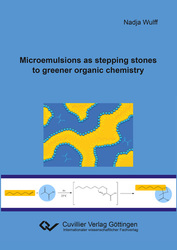| Departments | |
|---|---|
| Book Series (96) |
1378
|
| Nachhaltigkeit |
3
|
| Gesundheitswesen |
1
|
| Humanities |
2364
|
| Natural Sciences |
5406
|
| Mathematics | 229 |
| Informatics | 319 |
| Physics | 980 |
| Chemistry | 1363 |
| Geosciences | 131 |
| Human medicine | 243 |
| Stomatology | 10 |
| Veterinary medicine | 108 |
| Pharmacy | 147 |
| Biology | 835 |
| Biochemistry, molecular biology, gene technology | 121 |
| Biophysics | 25 |
| Domestic and nutritional science | 45 |
| Agricultural science | 1004 |
| Forest science | 201 |
| Horticultural science | 20 |
| Environmental research, ecology and landscape conservation | 148 |
| Engineering |
1793
|
| Common |
98
|
|
Leitlinien Unfallchirurgie
5. Auflage bestellen |
|
Advanced Search
Microemulsions as stepping stones to greener organic chemistry (English shop)
Nadja Wulff (Author)Preview
Table of Contents, PDF (130 KB)
Extract, PDF (310 KB)
In organic chemistry the simultaneous solubility of hydrophobic and hydrophilic reactants in a common solvent is an ubiquitous problem. Often either an expensive or a toxic solvent is needed. Alternatively, polar and non polar components are mixed into macroemulsions permitting them to react across the internal interface. However, macroemulsions display a comparatively small interfacial area. Thus, the reaction rate is low. Microemulsions feature an inherent vast interfacial area which facilitates significantly higher reaction rates. Furthermore, they allow a rather simple monitoring of the reaction kinetics by observing changes in the phase behavior. In this work the advantages of microemulsions as efficient reaction media for the photochemically induced Paternò Büchi reaction of pyruvic acid and 1 octene are elucidated. The amphiphilic reaction product 3 hexyl 2 methyloxetane 2 carboxylic acid influences the phase behavior of the microemulsion system significantly. With increasing UV exposure time the point of highest efficiency was shifted to lower temperatures and, interestingly, an increase of efficiency was detected. Hence, the newly created amphiphile acts as an efficient, hydrophobic cosurfactant. Additionally, with small angle neutron scattering and freeze fracture electron microscopy it was shown that the bicontinuous microstructure survives the UV irradiation. Another route towards green organic chemistry was opened by characterization of two new sustainable biosurfactants (mannosylerythritollipids (MEL) and cellobioselipids (CL)) in microemulsions.
| ISBN-13 (Hard Copy) | 9783954049097 |
| ISBN-13 (eBook) | 9783736949096 |
| Final Book Format | A5 |
| Language | English |
| Page Number | 166 |
| Lamination of Cover | matt |
| Edition | 1. Aufl. |
| Publication Place | Göttingen |
| Place of Dissertation | Köln |
| Publication Date | 2015-01-16 |
| General Categorization | Dissertation |
| Departments |
Organic chemistry
Physical chemistry |
| Keywords | microemulsion, reaction media, photochemistry, cycloaddition, Paterno-Büchi, ultrasound Mikroemulsionen, Reaktionsmedien, Photochemie, Ultraschall, SANS, FFEM |








